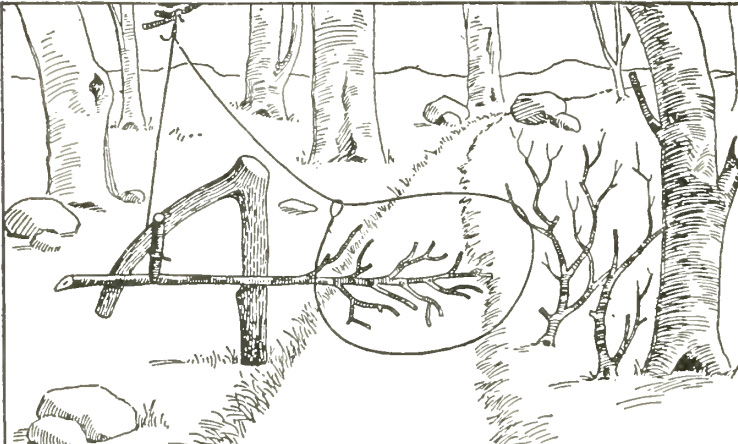Big Game Traps
Trapping small game animals is much easier and usually more productive as well, but learning how to trap large game is another useful survival skill. After all, trapping one large animal could produce as much meat as trapping one hundred small game animals. It’s for this reason that setting large game traps isn’t a bad idea at all – even if you spend most of your time focusing on small game traps.
The good news is that large game traps aren’t much different than small game traps.
Even though the materials used may be slightly different to account for the size and weight of larger game, the deadfall and the snare are still the most popular trapping methods for large game animals. The most effective large game trap is known as the deer snare (although it can be adjusted to trap a variety of large game animals). With the exception of bears, most large game will not be attracted to bait like smaller animals.
This makes trap location extremely important. If the trap is not set in an area where animals regularly travel, you have almost no chance of successfully trapping big game.
You need to spend a fair amount of time scouting before setting a trap. Although this is important for trapping animals large and small, it is especially important when setting up a deer snare. Look for well used game trails and evidence of recent animal activity.
These are the types of locations where a deer snare should be set up for best results. The small strands of copper wire used to make small game snares won’t work for larger animals. Constructing a deer snare requires a length of heavy duty cable approximately 15 feet long. Although the thickness of the cable can vary, try to use something between 1/16” and 1/4”.
This is strong enough to hold a variety of large game without being too obvious to the animals as they travel through the wilderness. Since cable is not as easily manipulated as small pieces of copper wire, a small metal plate is used to form the noose.
This metal plate should have two holes drilled through it for the cable to pass through and a cable clamp is used to secure one end of the cable to the metal plate.
It’s worth pointing out that large game traps like the deer snare aren’t as easy to assemble in the field. These traps should be constructed at home before a disaster occurs and stored for later use. Also, unlike small game snares which are effective no matter which part of the animal gets caught, a deer snare needs to tighten around the animal’s neck to be effective.
This means the snare cannot sit on or near the ground. It should be elevated approximately two feet off the ground using a spring pole or another elevated object and attaching a string between the snare and this pole or object. The purpose of the spring pole is only to elevate the snare off the ground as it would be nearly impossible to lift a large game animal off the ground in the same manner as a spring pole snare designed for small game would.
The other end of the noose should be attached to a large object such as a boulder or log. This object serves as an anchor to keep the trapped animal from running off too fast. You do not want to keep the animal immobilized – this would create too much stress on the animal and ruin the meat. Instead, try to use an object weighing approximately 30 pounds.
This allows the animal to move, but at a much slower rate than normal making it relatively easy to track and harvest. A wide log makes a good anchor because the brush trail created as the trapped animal will make tracking down your prey much easier.
The example above shows what a deer snare might look like. Notice that the trap is set directly in the path that deer frequent. Also notice that there is no anchor in this setup. Instead, the trap is suspended from another tree branch.
Even the trigger is made from a tree branch in this example. What you should learn from this is that conditions won’t always be ideal to set up a deer snare the way it was described above, but that doesn’t mean you can’t make it work using the materials available. Deadfalls also work for large game in some circumstances. Most deer are not attracted to bait and deadfalls are not very successful without bait. For this reason, large game deadfalls are best used when targeting bears and other large game that are attracted to bait.

Of course, the other issue is that a deadfall large enough to kill a bear or other large mammal isn’t something easily constructed by one person.
Typically, a team of people would have to work together to construct one of these traps – an activity that may not be practical unless there are no other options available. Although trapping large game is much more difficult that trapping small game, don’t overlook this important survival technique.
Once a large game trap has been set, you don’t need to do anything other than check it regularly and all it only needs to work one time to produce at least a month’s worth of meat.

